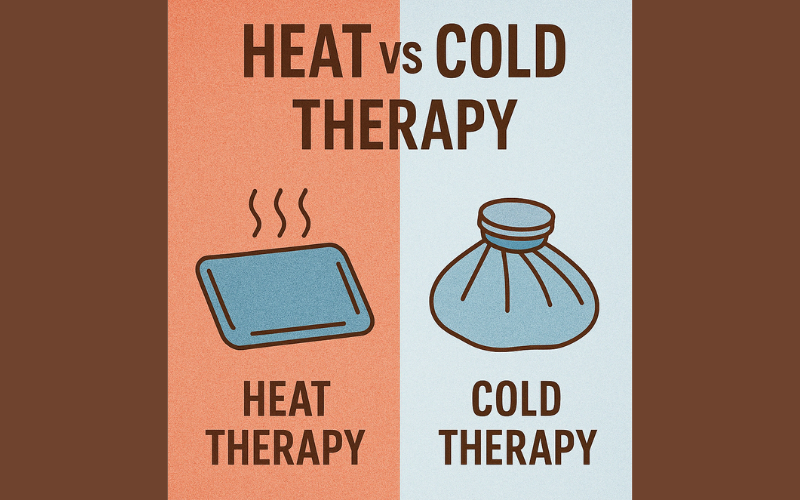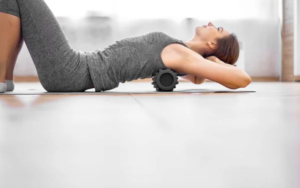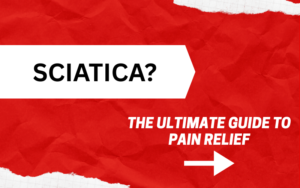If you’re dealing with pain, swelling, or sore muscles, you might be wondering: Should I use heat or ice? This is one of the most common questions people ask when trying to recover at home. Heat vs cold therapy for pain relief isn’t just about comfort—it can make a big difference in how fast you heal.
In this post, we’ll break down the benefits of both heat and cold therapy, when to use each one, and how to avoid common mistakes. Whether you have a fresh injury, chronic pain, or just finished a workout, this guide will help you choose the right treatment for faster relief.
Table of Contents
📢 Before you continue! Sign up below for weekly home recovery tips, injury rehab advice, and therapist-approved gear reviews straight to your inbox!!
🔥 What Is Heat Therapy?
Heat therapy—also called thermotherapy—uses warm temperatures to help relax muscles, improve blood flow, and reduce pain. It’s a common treatment for chronic pain, muscle tension, and stiff joints.
In the debate of heat vs cold therapy for pain relief, heat is usually best for long-term aches or tight muscles, not fresh injuries.
✅ How Heat Therapy Works
When you apply heat to your body, your blood vessels open up. This improves circulation, bringing more oxygen and nutrients to sore or tight areas. It also helps flush out waste that may cause stiffness or pain.
Heat can:
- Loosen tight muscles
- Increase flexibility
- Reduce joint stiffness
- Relieve ongoing (chronic) pain
- Help you feel more relaxed
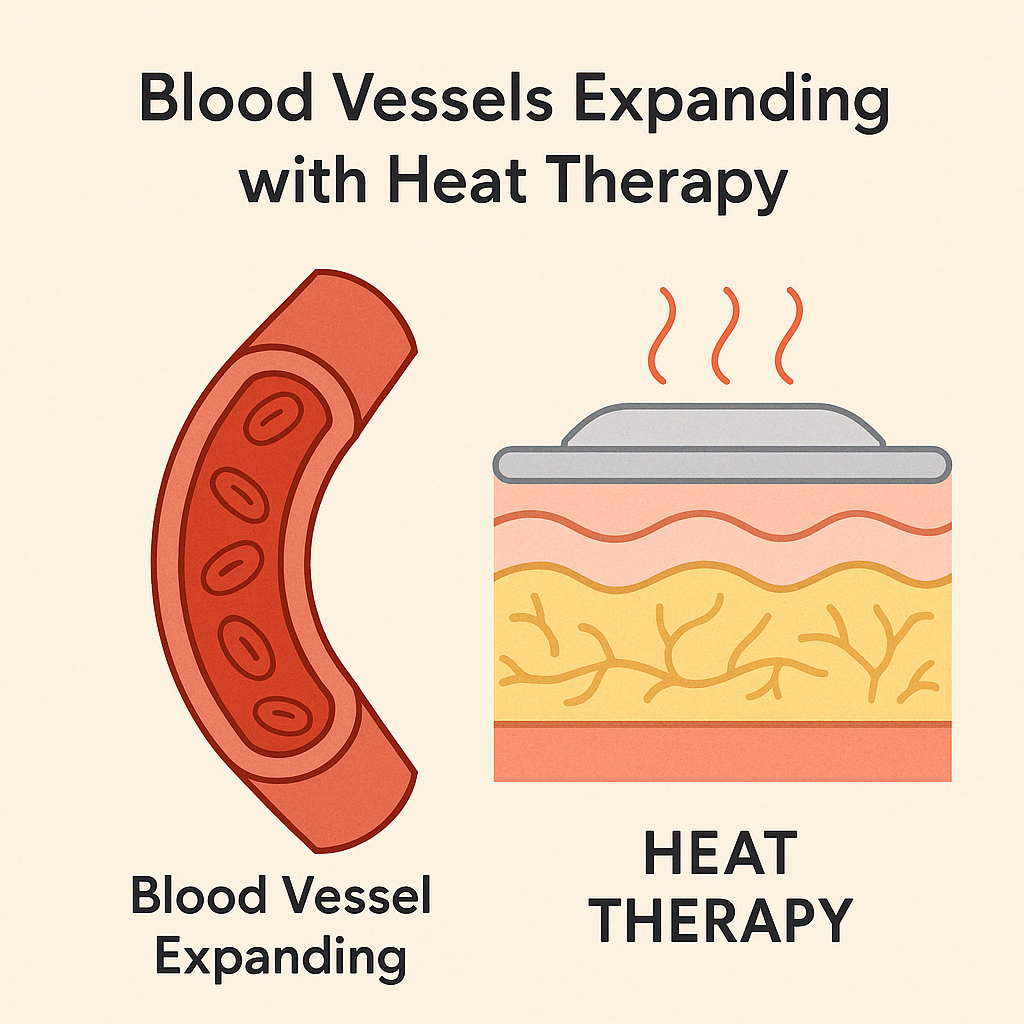
🔥 Types of Heat Therapy
There are two main types of heat therapy:
1. Dry Heat
This includes things like:
- Heating pads
- Heat wraps
- Electric blankets
Dry heat is easy to use and often more convenient for home treatment.
2. Moist Heat
This includes:
- Warm towels
- Hot baths or showers
- Steam treatments
Moist heat may work better for deep muscle pain or joint stiffness.
“Comparison Chart showing the differences between dry heat and moist heat therapy“
| Feature | Dry Heat | Moist Heat |
|---|---|---|
| Benefits | – Easy to apply – Stays warm longer – More portable | – Penetrates deeper into muscles – Works faster to relieve pain – Less drying to the skin |
| How to Use | – Electric heating pad – Infrared heat lamp – Heated blankets | – Warm towel – Moist heating pad – Hot water bottle or steam |
| Best For | – Chronic muscle pain – Long-term use at home – Traveling or work use | – Deep tissue soreness – Joint stiffness – Post-workout recovery |
💡 When to Use Heat Therapy
Heat therapy is most helpful for:
- Chronic pain (lasting more than a few weeks)
- Muscle tension from stress or overuse
- Joint stiffness, like in arthritis
- Old injuries with lingering soreness
🛑 Don’t use heat on new injuries or swollen areas. It can make inflammation worse.
⏱️ How Long Should You Use Heat Therapy?
Most people start with 15 to 20 minutes at a time. You can use it 2 to 3 times a day, but always check your skin to avoid burns. If you’re unsure, talk to a physical therapist or doctor.
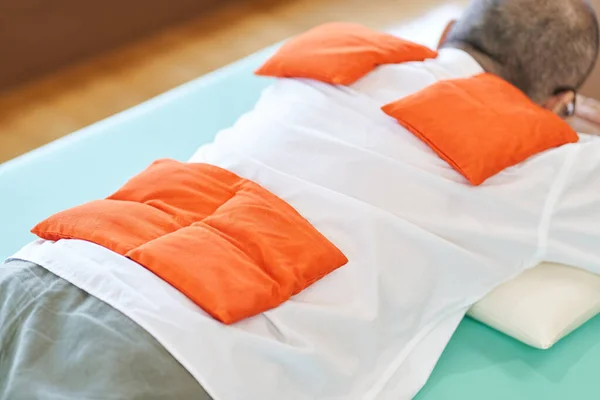
🧠 Quick Tip:
If you’re unsure about heat vs cold therapy for pain relief, a good rule is:
Use cold for swelling or new injuries. Use heat for tight muscles or stiffness.
❄️ What Is Cold Therapy?
Cold therapy, also known as cryotherapy, uses cold temperatures to reduce pain, swelling, and inflammation. It works best for new injuries, acute pain, or after intense physical activity.
In the heat vs cold therapy for pain relief conversation, cold is the go-to treatment when your body needs to calm down and recover quickly.
❄️ How Cold Therapy Works
When you apply cold to your body, it causes your blood vessels to narrow. This helps slow down blood flow to the area, which reduces swelling, inflammation, and pain signals from nerves.
Cold therapy can:
- Numb sharp or intense pain
- Decrease swelling after injury
- Calm down inflammation
- Reduce bruising
- Prevent further tissue damage after trauma
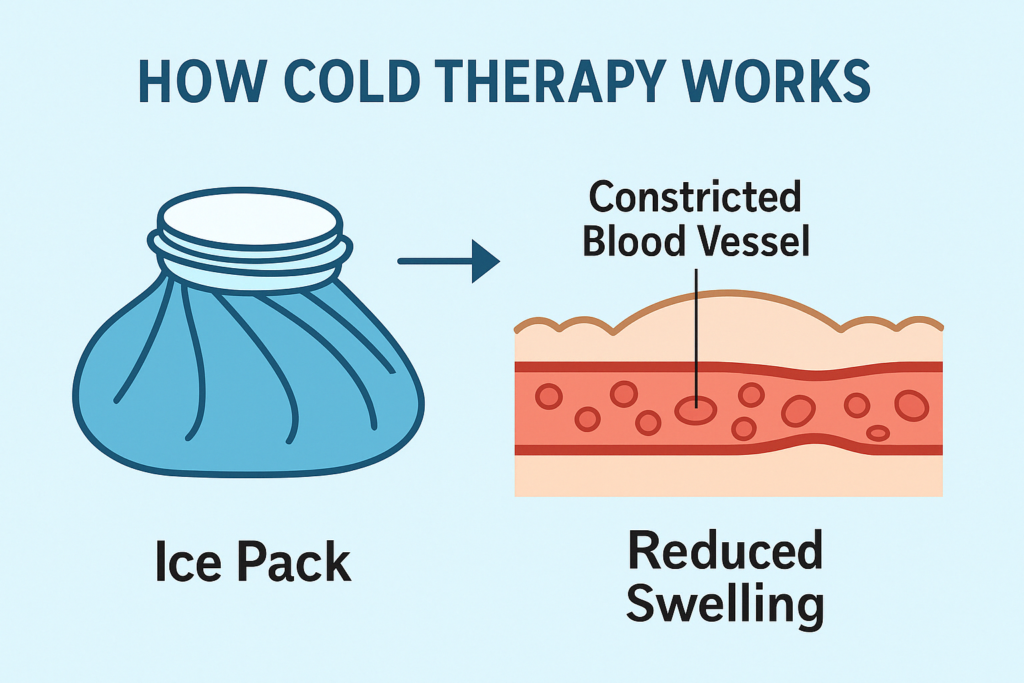
🧊 Types of Cold Therapy
There are several easy ways to use cold therapy at home:
1. Ice Packs
Reusable gel packs or bags of ice wrapped in a towel are great for targeted pain relief.
2. Cold Compresses
These are soft, flexible wraps that stay cool and fit easily around joints or muscles.
3. Cold Water or Ice Baths
Used by athletes for full-body recovery after intense workouts.
4. Cryo Sprays or Cooling Gels
These provide fast, surface-level cooling for sore spots on the go.
“Chart Comparing different cold therapy methods by use case, duration, and target area“
| Cold Therapy Method | Best Use Case | Recommended Duration | Target Areas |
|---|---|---|---|
| Ice Pack (gel or crushed ice) | Acute injuries, swelling, post-surgery | 10–15 minutes | Knees, ankles, shoulders, back |
| Cold Compression Wrap | Inflammation, sprains, joint pain | 15–20 minutes | Joints (knees, elbows, wrists, ankles) |
| Ice Massage (ice cup) | Localized muscle knots, tendonitis | 5–10 minutes | Small areas: forearm, heel, elbow |
| Cold Water Immersion (ice bath) | Post-workout recovery, full body soreness | 5–15 minutes | Whole body, legs, feet |
| Cryotherapy Chamber | Athletic recovery, systemic inflammation | 2–4 minutes | Whole body |
✅ When to Use Cold Therapy
Cold therapy is best for:
- Recent injuries (within the last 48 hours)
- Swelling and bruising
- Acute pain
- Strains or sprains
- Post-surgery recovery
🛑 Don’t use cold on stiff or tight muscles. It may make them feel even tighter.
⏱️ How Long Should You Use Cold Therapy?
Apply cold for 10 to 15 minutes at a time. You can repeat every 2 to 3 hours in the first day or two after an injury.
Always wrap ice packs in a towel—never apply directly to the skin.
🧠 Quick Tip:
If your pain is sharp, sudden, or swollen, start with cold. If it’s stiff, sore, or long-lasting, go with heat.
♨️❄️ Heat vs Cold for Specific Conditions
Knowing when to use heat or cold therapy depends on what kind of pain or injury you have. Here’s a breakdown of the most common conditions and which type of therapy is best for each.
🔹 1. Muscle Soreness or Stiffness
Use Heat.
Heat helps relax tight or overworked muscles and boosts blood flow to speed up recovery. It’s great after workouts or long periods of sitting.
Tip: Use a heating pad on sore shoulders, back, or legs for 15–20 minutes.
🔹 2. Acute Injuries (Sprains, Strains, Bruises)
Use Cold.
Cold therapy is best right after an injury. It reduces swelling, numbs pain, and protects the injured area from more damage.
Tip: Apply an ice pack every 2–3 hours for the first 48 hours after injury.
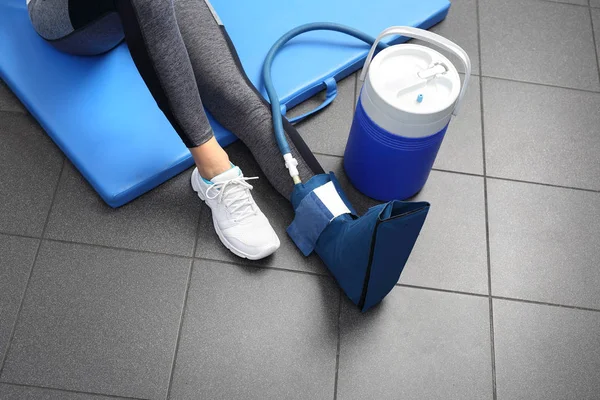
🔹 3. Arthritis
Use Heat for stiffness, Cold for flare-ups.
Heat can loosen stiff joints in the morning, while cold reduces swelling and sharp pain during flare-ups.
Tip: Try warm compresses in the morning and cold packs if joints swell later in the day.
🔹 4. Back Pain
Use Heat for muscle tension, Cold for injury or inflammation.
If your back pain is caused by tight muscles or stress, heat can soothe and relax it. But if there’s swelling or it’s a fresh injury, cold is better.
Tip: A warm heating pad can help with low back tension, while a cold pack is better after lifting something heavy.
🔹 5. Headaches or Migraines
Use Cold.
Cold packs placed on the forehead, neck, or temples may reduce headache intensity by calming down blood flow and nerve signals.
Tip: Wrap a cold pack in a thin towel and apply for 10–15 minutes.
🔹 6. Post-Surgery Recovery
Start with Cold, Then Switch to Heat (if advised).
Cold therapy helps control swelling and pain after surgery. Later, heat may be used (with your doctor’s approval) to improve mobility and reduce stiffness.
Tip: Always follow your surgeon’s or physical therapist’s instructions for safe use.
“Table listing common conditions with “Use Heat” or “Use Cold”
| Condition | Use Heat or Cold | Why |
|---|---|---|
| Muscle soreness (chronic) | 🔥 Use Heat | Relaxes tight muscles and improves blood flow. |
| Muscle strain (recent) | ❄️ Use Cold | Reduces inflammation and numbs sharp pain. |
| Arthritis (non-flare up) | 🔥 Use Heat | Eases stiffness and improves joint flexibility. |
| Arthritis (flare-up) | ❄️ Use Cold | Calms swelling and joint inflammation. |
| Back pain (chronic) | 🔥 Use Heat | Soothes tension and promotes circulation. |
| Sprained ankle (fresh injury) | ❄️ Use Cold | Helps control swelling and numbs the area. |
| Tendonitis | ❄️ Use Cold | Reduces irritation and inflammation. |
| Stiff neck | 🔥 Use Heat | Loosens muscles and relieves tightness. |
| Migraine or headache | ❄️ Use Cold | Constricts blood vessels to ease throbbing. |
| Menstrual cramps | 🔥 Use Heat | Relaxes uterine muscles and relieves pain. |
💡 Pro Tip:
When in doubt, follow the “Cold First, Heat Later” rule:
Cold is for injuries. Heat is for healing.
🏠 How to Safely Use Heat and Cold Therapy at Home
Using heat and cold therapy at home is simple—but only if you do it the right way. Using these treatments incorrectly can lead to burns, frostbite, or make pain worse. Follow these tips to stay safe and get the most out of your recovery.
✅ Safety Tips for Heat Therapy
- Always use a barrier
Never place a heating pad or hot compress directly on your skin. Use a towel or cloth in between. - Stick to 15–20 minute sessions
More time doesn’t mean better results. Too much heat can damage skin or nerves. - Check your skin
If it gets too red, irritated, or painful, stop right away. - Avoid if you have poor circulation or nerve damage
People with diabetes or certain conditions may not feel heat properly and could get burned.
❄️ Safety Tips for Cold Therapy
- Never apply ice directly to skin
Always wrap ice or gel packs in a thin towel to avoid frostbite. - Limit to 10–15 minutes per session
Cold therapy is powerful—even short exposure can be enough to reduce swelling and pain. - Take breaks between sessions
Wait at least 1 hour before reapplying ice to the same area. - Avoid using cold if you have poor circulation
People with Raynaud’s or similar conditions should talk to a doctor first.
🧠 Know When to Call a Professional
If your pain lasts more than a few days, gets worse, or you’re not sure whether to use heat or cold, talk to a physical therapist or doctor. Sometimes pain is a sign of a bigger issue that needs expert care.
🛑 Quick Do’s and Don’ts
| Do | Don’t |
|---|---|
| Use a cloth barrier | Apply directly to skin |
| Set a timer | Fall asleep with heat/cold on |
| Start with short sessions | Use for over 20 minutes |
| Check your skin often | Ignore signs of redness or irritation |
🛒 Physical Therapy Recommendations
Want fast, reliable relief at home? Whether you’re dealing with sore muscles, joint pain, or a fresh injury, having the right tools on hand can make all the difference. Below are some top-rated heat and cold therapy products that physical therapists often recommend—and they’re available on Amazon.
✅ These are affiliate links, which means we may earn a small commission at no extra cost to you. Thank you for supporting our blog!
🔍 Heat vs Cold Therapy Product Comparison Table
| Product | Type | Best For | Key Features | Buy Link |
|---|---|---|---|---|
| Sunbeam Heating Pad | Heat | Back pain, cramps, stiffness | Soft fabric, 3 heat settings, moist/dry heat | 🔗 Shop Now |
| Thermophore MaxHeat Pad | Heat | Chronic pain, arthritis | Deep moist heat, extra large size, auto shut-off | 🔗 Shop Now |
| FlexiKold Gel Ice Pack | Cold | Swelling, injuries, post-surgery | Reusable, flexible, stays cold longer | 🔗 Shop Now |
| REVIX Shoulder Ice Wrap | Cold | Shoulder pain, soreness, inflammation | Adjustable straps, covers full shoulder joint | 🔗 Shop Now |
💬 Quick Buying Tips:
- Choose heat therapy if you’re dealing with stiffness, soreness, or chronic pain.
- Pick cold therapy for swelling, recent injuries, or sharp pain.
- Bundle both if you want all-in-one home relief!
💡 Pro Tip:
Keep one heat and one cold pack in your home kit so you’re always prepared—no matter what kind of pain pops up.
🧾 Final Thoughts: Heat vs Cold Therapy for Pain Relief
When it comes to heat vs cold therapy for pain relief, the choice depends on your pain type, injury stage, and personal comfort.
Here’s a quick recap:
- 🧊 Cold therapy is best for new injuries, swelling, and acute pain. Use it in the first 48 hours to calm inflammation.
- 🔥 Heat therapy works best for stiff muscles, chronic pain, and joint tightness. Use it to relax and improve blood flow.
Both are safe, affordable ways to manage pain at home—just make sure you follow proper safety tips and use the right tools.


